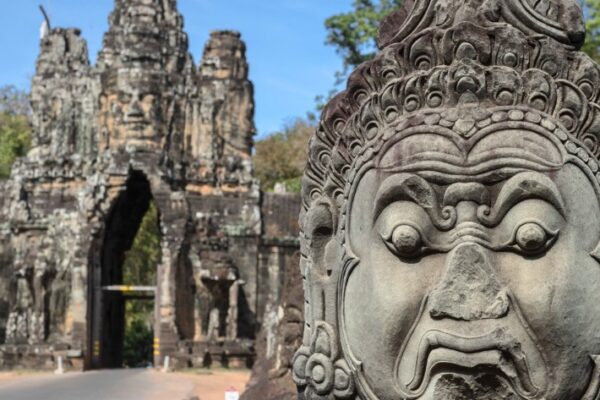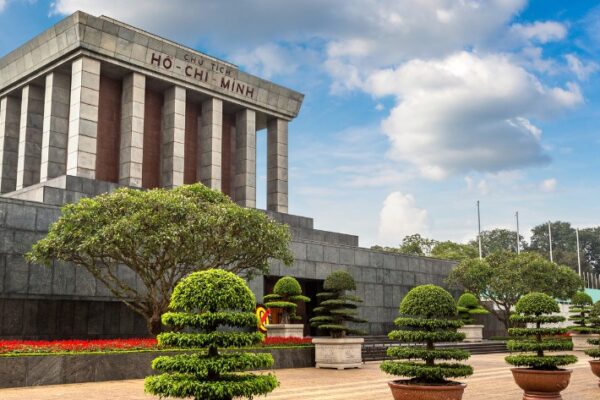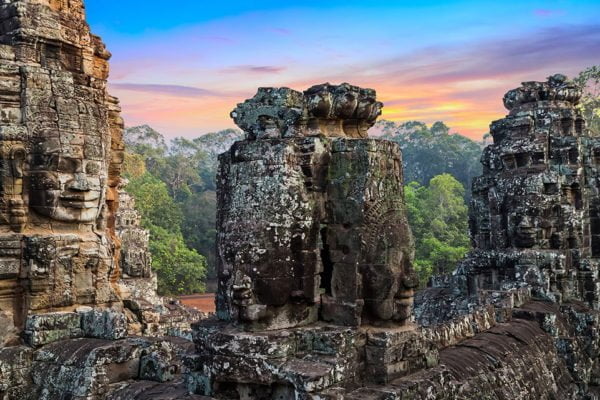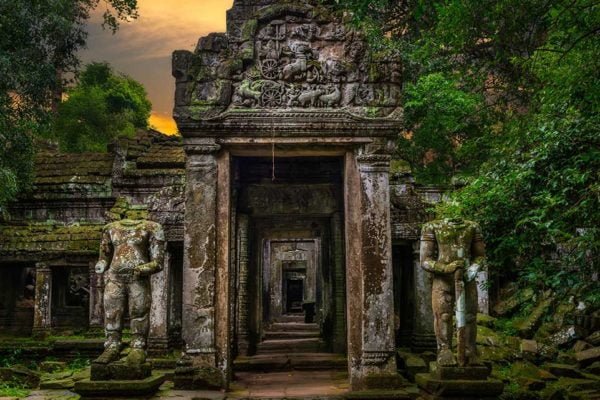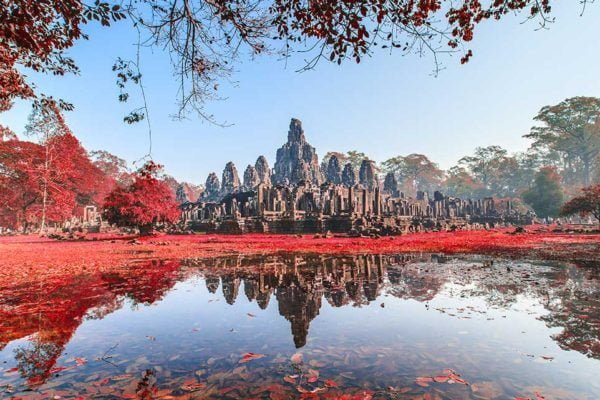Angkor Complex – Travel Guide To Explore The Most Majestic Site of Cambodia
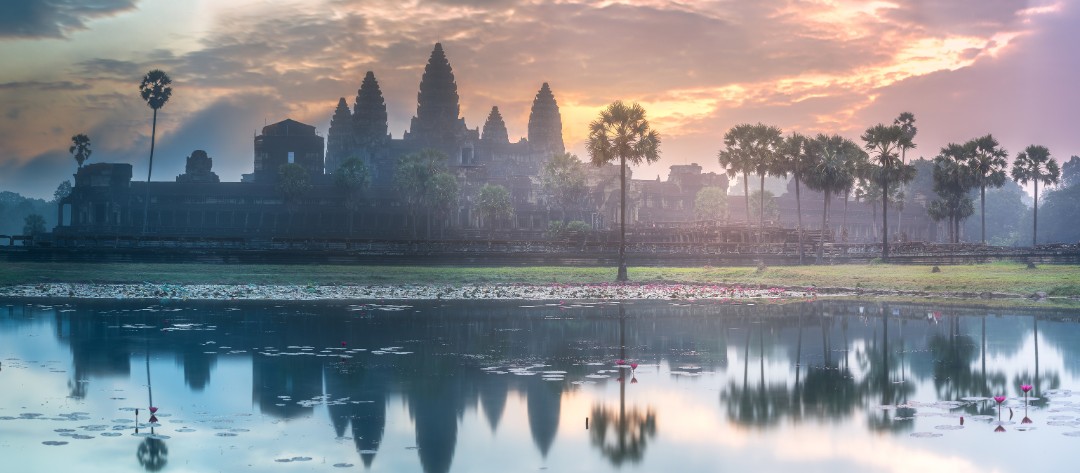
Welcome to the Angkor Complex, Cambodia’s crowning jewel and a mesmerizing testament to the architectural prowess of the ancient Khmer Empire. This sprawling UNESCO World Heritage site, home to the spectacular Angkor Wat and numerous other temples, palaces, and monuments, offers a profound glimpse into a civilization that flourished between the 9th and 15th centuries.
As you explore its vast ruins, you’ll encounter intricate carvings, towering stone faces, and awe-inspiring structures that narrate stories of religious devotion, imperial might, and artistic sophistication. Each step through this ancient site not only reveals the grandeur of Cambodia’s history but also connects visitors deeply with the spirit and heritage of its people.
History of the Angkor Complex
The Angkor Complex, located in the northern province of Siem Reap, Cambodia, is a sprawling network of temples, reservoirs, and canals that reflect the grandeur of the Khmer Empire at its zenith.
The history of Angkor begins in the 9th century, when King Jayavarman II founded the Khmer Empire, establishing a series of capitals and monumental temples that symbolized his divine rule. The most significant period of building occurred between the 11th and 13th centuries under the reigns of kings such as Suryavarman II and Jayavarman VII.
Suryavarman II commissioned Angkor Wat in the early 12th century, originally dedicated to the Hindu god Vishnu. It later became a Buddhist temple, showcasing the empire’s religious fluidity. Jayavarman VII, known for his profound Buddhist faith, constructed the Bayon Temple, famous for its serene stone faces, and the walled city of Angkor Thom, further emphasizing Buddhism’s influence.

Life of King Suryavarman II
The decline of the Angkor Complex began in the 15th century, attributed to overpopulation, environmental degradation, and pressure from Thai kingdoms. This led to the abandonment of Angkor, with the capital moving closer to present-day Phnom Penh. Rediscovered in the 19th century by French explorers, Angkor has since undergone extensive restoration efforts spearheaded by both Cambodian authorities and international teams, reviving its legacy as a symbol of Khmer architectural and cultural prowess.
Its Cultural Significance
The Angkor Complex remains a cornerstone of Cambodian cultural identity and pride. Beyond its architectural achievements, the site encapsulates the spiritual and social dynamics of the Khmer Empire. Angkor Wat itself is depicted on Cambodia’s national flag, symbolizing the everlasting spirit of the Khmer people and their enduring heritage.
Tradition Blend
The temples of Angkor are steeped in both Hindu and Buddhist traditions, reflecting a period in Southeast Asia where cultural and religious ideas were in flux and often intertwined. This blending of beliefs is visible in the eclectic iconography and architectural styles across the complex. For the local Khmer community, these temples serve not only as a link to their historical past but also as active places of worship and pilgrimage, particularly during religious festivals like the Angkor Sangkran.
Global Impact
Internationally, the Angkor Complex has contributed significantly to the global understanding of city planning and religious architecture in the pre-industrial world. Scholars and historians continue to study its advanced hydraulic systems and urban layout, which offer insights into the sophisticated societal and technological advancements of the Khmer Empire.
Continuous Preservation
The ongoing preservation and understanding of Angkor’s temples also highlight issues of cultural heritage management, involving careful balancing between tourism-driven economic benefits and the need to protect and maintain this invaluable historical site. Through such efforts, the Angkor Complex not only remains a vital part of Cambodia’s cultural landscape but also serves as a poignant reminder of human creativity and resilience.
Key Attractions You Can’t Miss in the Angkor Complex
The Angkor Complex is a vast and intricate ensemble of historical sites and temples. Visitors can explore these through two main routes, the Angkor Small Circuit and the Angkor Grand Circuit. Each circuit showcases unique and magnificent temples with distinct architectural styles and historical value.
Angkor Small Circuit
Angkor Wat
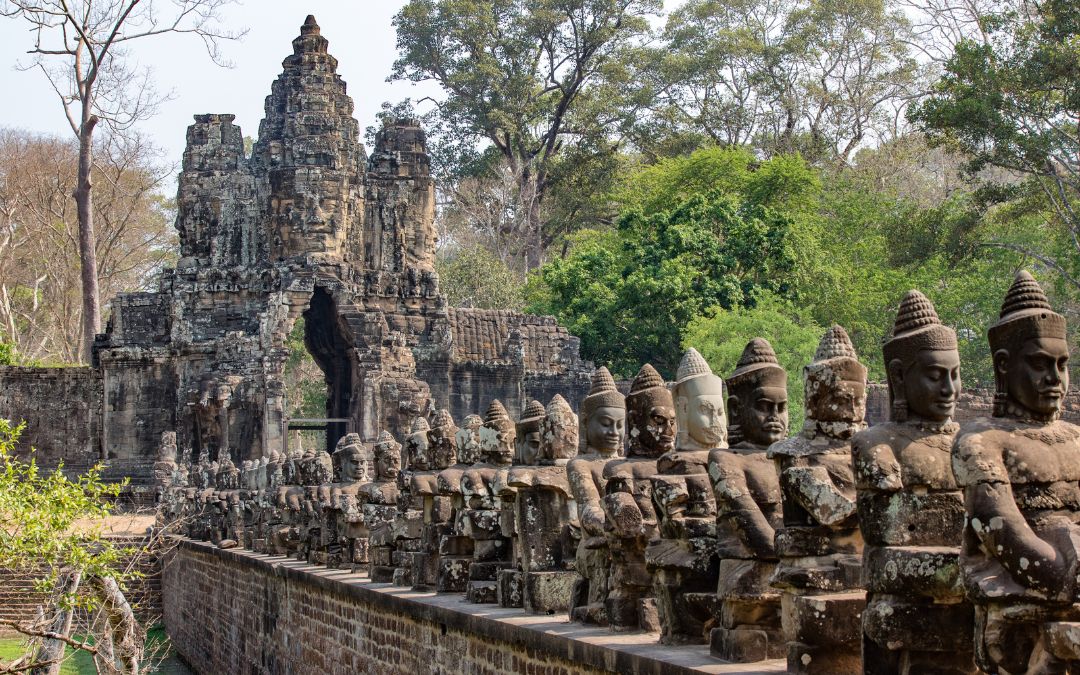
A magnificent example of Khmer architecture
This centerpiece of the Angkor Complex was built by King Suryavarman II in the 12th century. Originally a Hindu temple dedicated to Vishnu, it became a Buddhist temple in the late 12th century, reflecting the change in the region’s religious beliefs. This transition is evident in the temple’s art and structural modifications.
Angkor Wat is surrounded by a 5-kilometer-long moat and a 3.6-kilometer outer wall. The temple complex represents the Hindu universe and symbolizes Mount Meru, the center of the world in Hindu cosmology. It has three ascending galleries that lead to a central sanctuary surrounded by five towers that represent Meru’s peaks.
The temple’s westward orientation associates it with the setting sun and death, making it a temple and mausoleum for Suryavarman II. The bas-reliefs on the walls are intended to be viewed from left to right, which aligns with Hindu funeral rituals and reinforces its westward orientation.
Angkor Thom
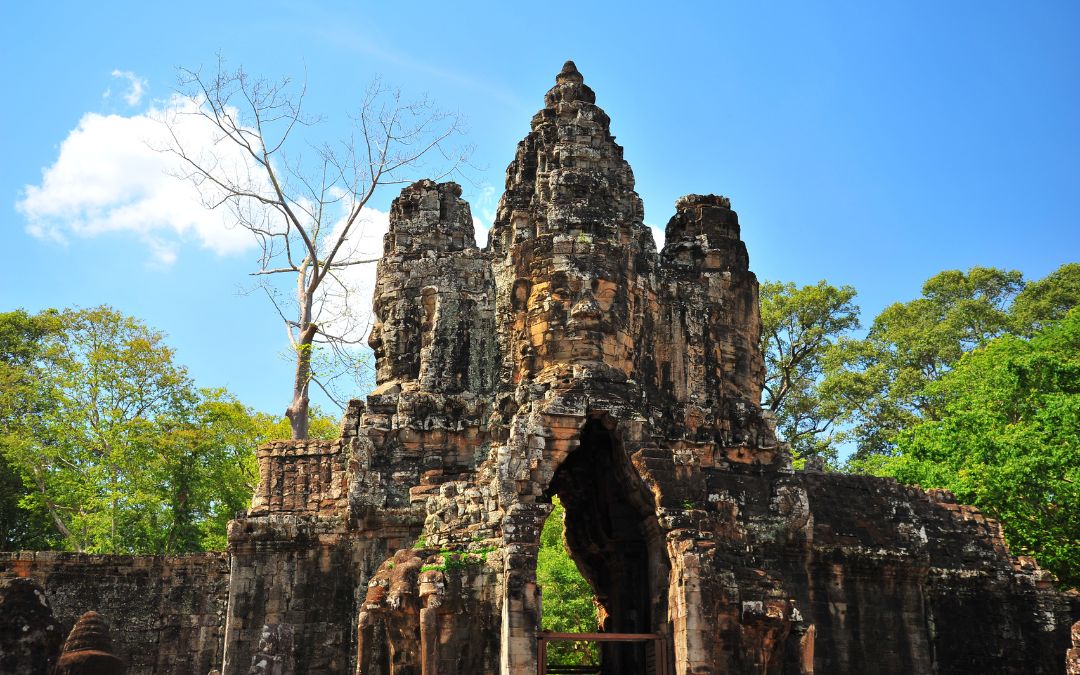
Stone gate to Angkor Thom
Angkor Thom, the last capital of the Khmer Empire under King Jayavarman VII, covers 9 square kilometers and features several monumental structures within its walls. The city is famed for the Bayon Temple at its center, which epitomizes the Bayon style with its face-towers, extensive use of laterite, and elaborate carvings.
The city’s gates are architectural marvels themselves, each crowned with a four-faced tower and flanked by giant figures of gods and demons depicting the “Churning of the Ocean of Milk.” The South Gate, the most visited, serves as a grand entrance from Angkor Wat to Angkor Thom.
Inside, temples like Phimeanakas, Baphuon, and the terraces of the Elephants and the Leper King illustrate the grandeur of Jayavarman VII’s reign. The Bayon, with its 54 towers and 216 serene stone faces, possibly represents the bodhisattva Avalokiteshvara or a fusion of the king and Buddha. The temple’s bas-reliefs, extending over 1.2 kilometers and depicting over 11,000 figures, narrate a mix of mythological, historical, and daily life scenes from the Angkorian period.
Ta Prohm
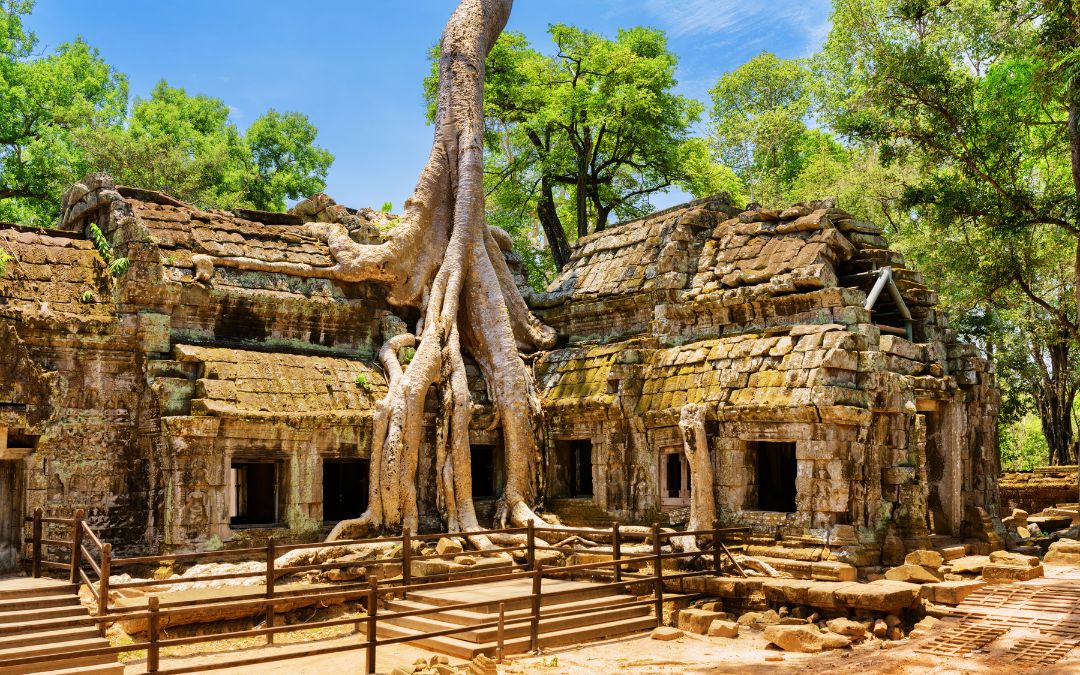
Ta Prohm temple overgrown with tree
Built during the reign of King Jayavarman VII, Ta Prohm is renowned for its overgrown state. Trees intertwine with ancient stones, creating a photogenic tableau of nature reclaiming man-made structures.
Originally established as a Mahayana Buddhist monastery and university, this temple has been preserved in much the same condition in which it was found, emphasizing its mystical and romantic appeal.
As indicated by its inscriptions, the temple complex supported a substantial community, including thousands of people from surrounding villages. Recently, efforts to stabilize and preserve the site have introduced structures like wooden walkways to manage tourist impact.
Ta Prohm gained additional fame as a filming location for the movie “Tomb Raider,” further cementing its status as one of Angkor’s must-visit destinations.
Ta Keo
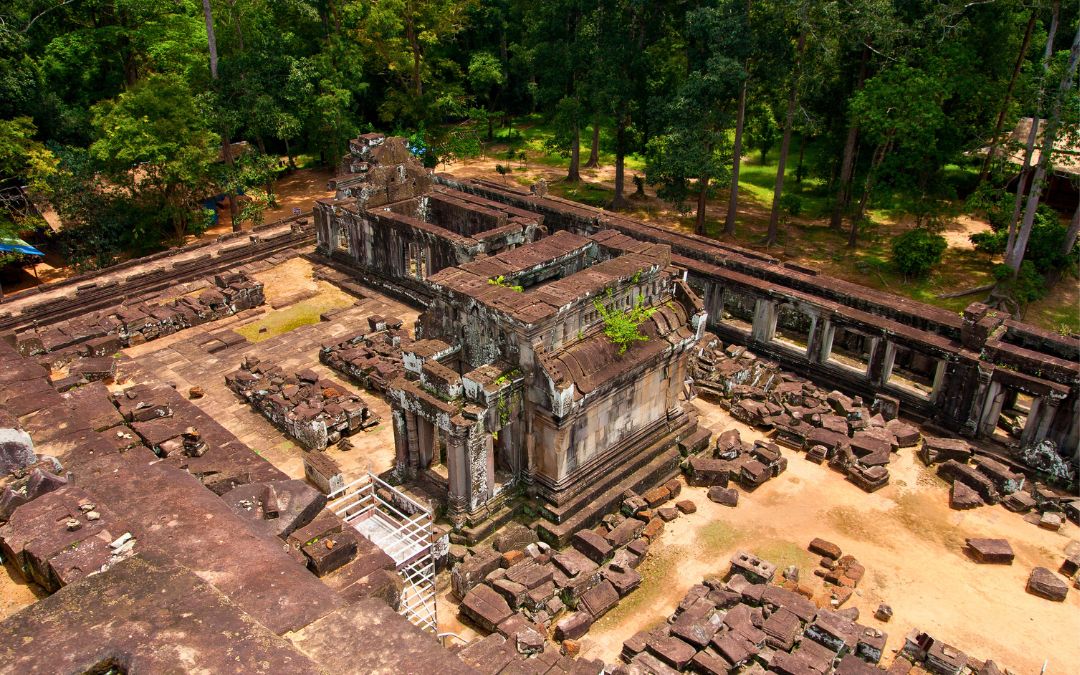
Ta Keo is a sandstone temple mountain commissioned by Jayavarman V
This temple, which predates the 11th century, stands out due to its unfinished state, possibly halted by a lightning strike considered an ill omen or perhaps due to the death of its patron. It represents Mount Meru with its five towers and stepped terraces but is notably devoid of the intricate carvings typical of other temples, giving it a stark, sculptural feel.
Banteay Kdei
Known as the “Citadel of Chambers” or “Citadel of Monks’ Cells,” Banteay Kdei was built in the mid-12th to early 13th centuries under Jayavarman VII.
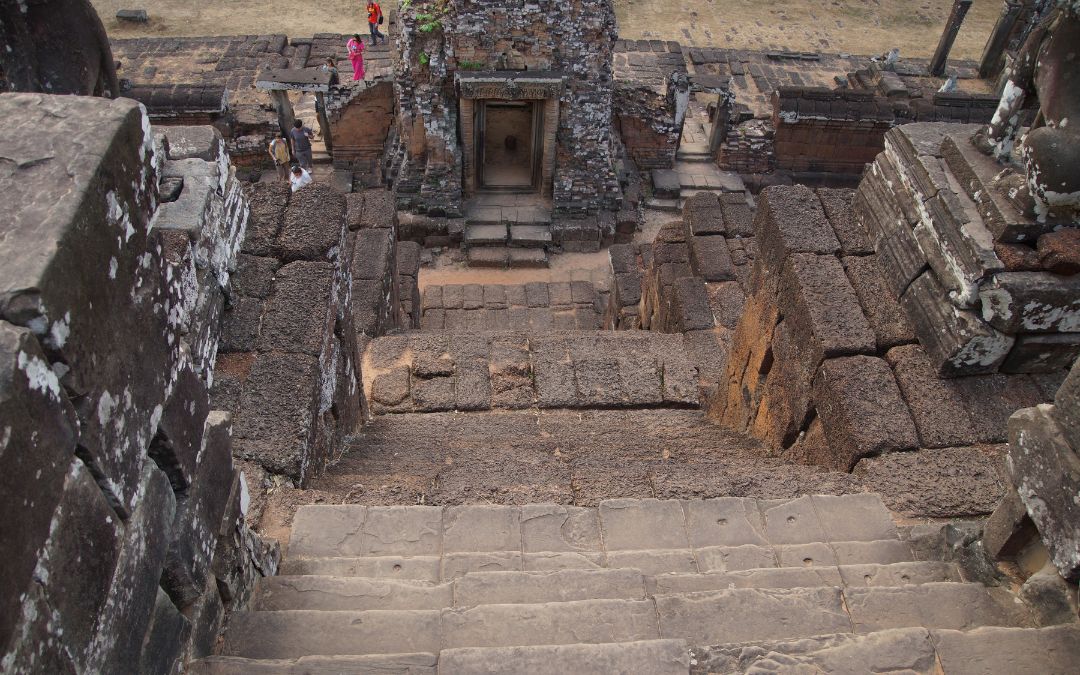
Steep stone stairway of Banteay Kdei
This Buddhist temple mirrors the architectural styles of Ta Prohm and Preah Khan but on a smaller and simpler scale. It features two concentric galleries and several towers, with the outer enclosure walls pierced by gates adorned with the iconic face towers, similar to those at Angkor Thom.
Adjacent to the royal bathing pool of Srah Srang, Banteay Kdei offers a more tranquil alternative to the more frequented temples, making it an ideal spot for visitors seeking a quieter experience of Angkor’s historical and architectural wonder.
Angkor Grand Circuit
Preah Khan
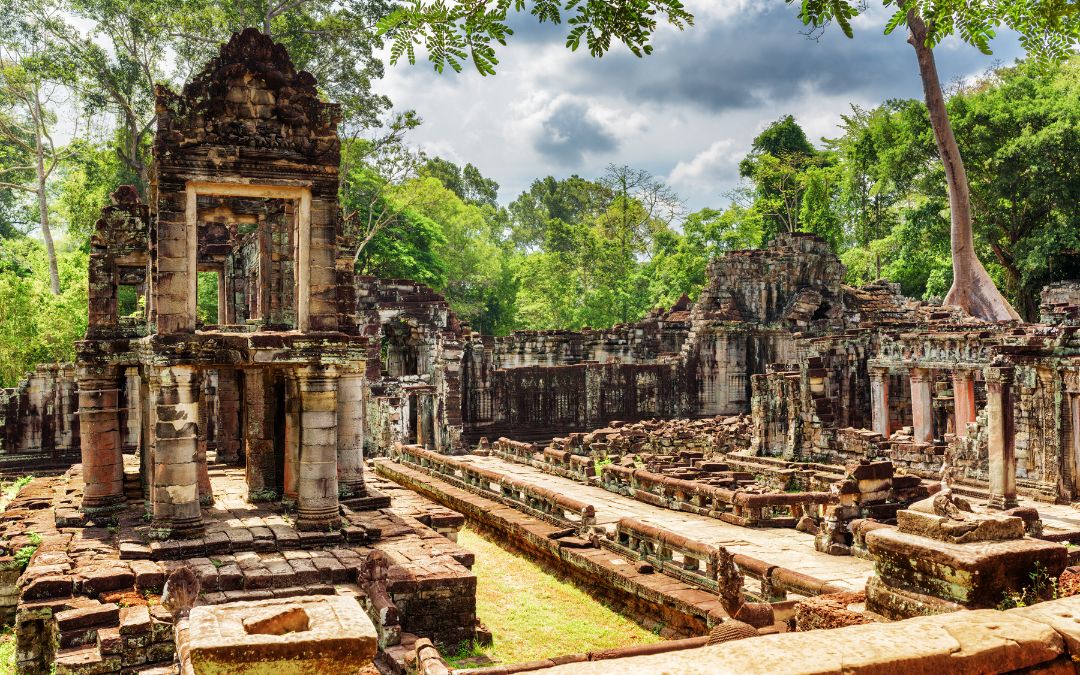
Preah Khan temple is located at the northern edge of Angkor Park
Preah Khan is a sprawling temple complex built in the 12th century by King Jayavarman VII to honor his father.
The temple’s design includes a series of rectangular galleries with flat architecture, adorned with intricate carvings of Garudas, eagle-like divine beings. Covering 138 acres, it features a rich array of structures including entryways, towers, courtyards, and shrines, with a central Buddhist sanctuary surrounded by smaller Hindu temples.
A stele discovered in 1939 reveals that Preah Khan was once served by nearly 100,000 people, including farmers, monks, and dancers, and was rich in treasures such as gold, silver, and gems. Conservation efforts began in 1991, focusing on stabilizing the structures amidst the encroaching forest.
A notable photographic spot is the massive tree rooted at the temple’s back entrance, embodying the picturesque union of nature and ancient architecture.
Neak Pean
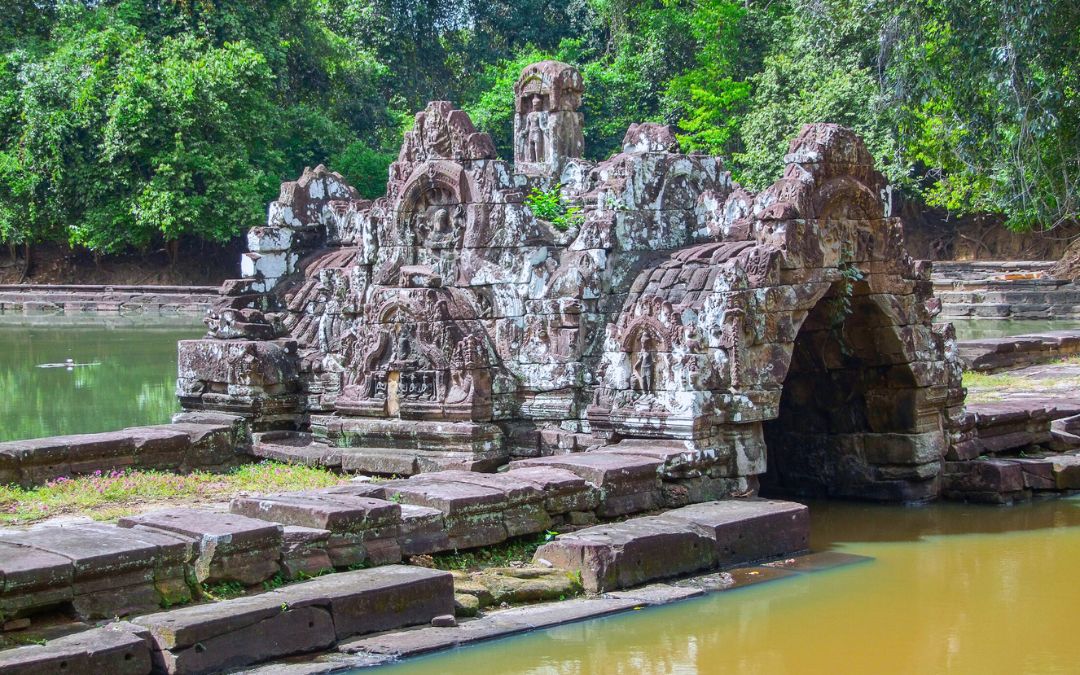
A unique archaeological site within Angkor
Neak Pean consists of a central pond surrounded by four smaller basins. The name, which translates to “The Entwined Serpents,” stems from the serpent carvings that decorate the base of the central tower.
Accessible via a long boardwalk over the water, this temple was built during the 12th century under King Jayavarman VII and is thought to represent Anavatapta, a mythical lake in the Himalayas with healing waters.
Designed with the ancient Hindu concept of balance in mind, the four surrounding ponds symbolize the elements of Water, Earth, Fire, and Wind. Stone conduits connect these to the central basin, each guarded by statues of the Four Great Animals: Elephant, Bull, Horse, and Lion. Neak Pean offers a serene environment ideal for reflection and meditation.
Ta Som

Inside the Ta Som temple
Ta Som is a smaller, less frequented temple in Angkor Park, built towards the end of the 12th century.
Its exact historical purpose remains unclear, though it’s speculated to have been dedicated to King Jayavarman VII’s father or one of his teachers. Enclosed by a moat and three concentric laterite walls, the temple features two sets of entrance gateways adorned with the Bayon-style four-faced carvings of Avalokiteshvara.
Like Preah Khan and Ta Prohm, Ta Som has been left largely unrestored, with nature intertwining with its architecture. The eastern entrance, embraced by a large Ficus tree, offers a picturesque scene reminiscent of the famous Ta Prohm Temple but without the crowds.
East Mebon
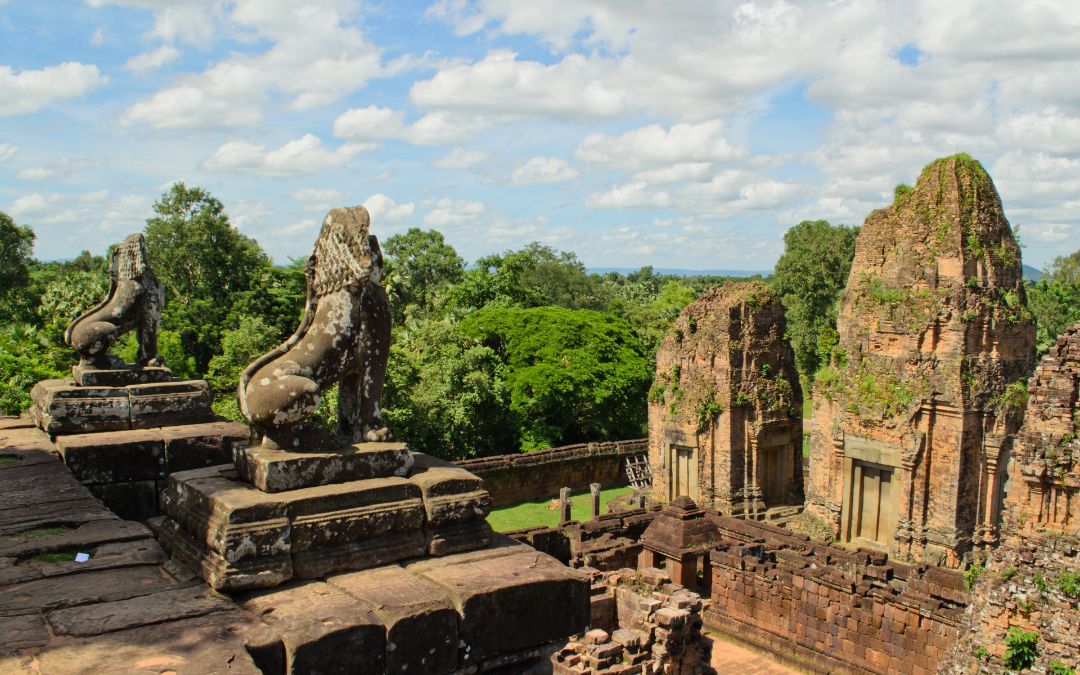
Lion Statue in the East Mebon
East Mebon, a 10th-century temple, was constructed on what was once an artificial island at the center of the now-dry Eastern Baray.
Built under King Rajendravarman, it was dedicated to the Hindu god Shiva and commemorates the king’s parents. This three-tiered temple-mountain is made from a combination of sandstone, brick, laterite, and stucco, and is noted for its exquisite sculptures, including two-meter-high stone elephants on its tiers.
Visitors on the upper levels can imagine the vast expanse of the Eastern Baray, which once surrounded the temple, originally accessible only by boat.
Pre Rup
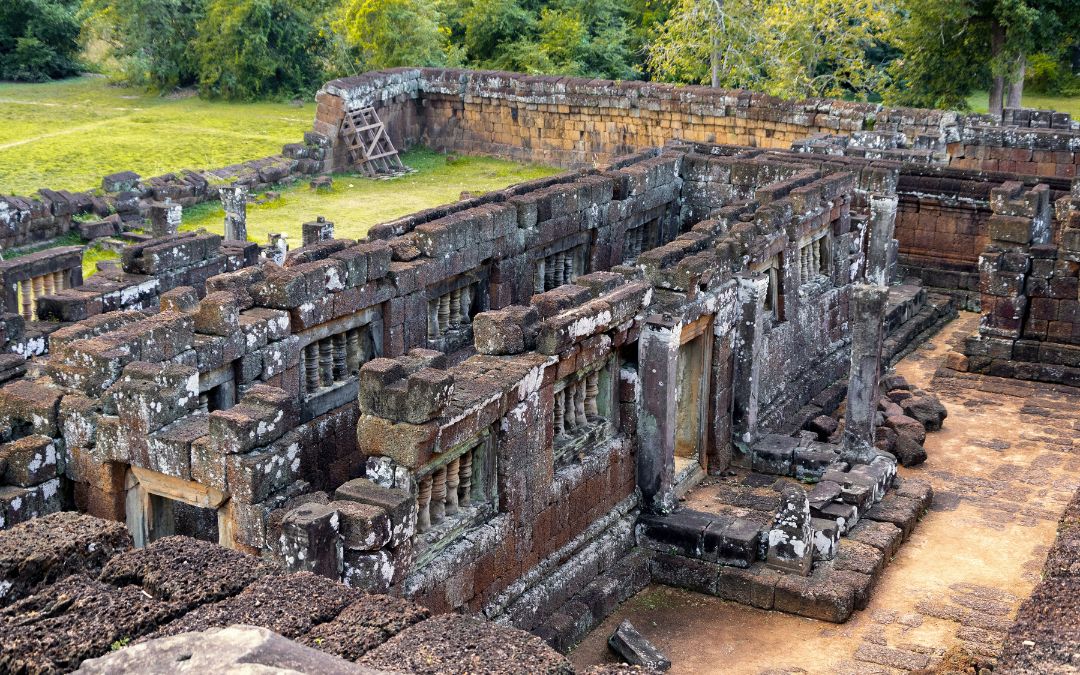
The ruins of Pre Rup temple
Pre Rup, constructed in 961 or early 962, served as the state temple of King Rajendravarman and is dedicated to the Hindu god Shiva. Its name, meaning “turn the body,” reflects a Cambodian funerary tradition. Architecturally similar to East Mebon but distinguished by its steeper pyramid and reddish brickwork, Pre Rup is particularly striking under the midday sun.
Visitors can climb the steep steps to the temple’s upper terraces, where they are rewarded with breathtaking views of the sunset over the Cambodian landscape, making it a favored spot for ending a day of exploration in Angkor.
Other Attractions in the Area
While the Angkor Complex is an impressive tourist destination, the surrounding area also offers insights into the region’s history, culture, and natural beauty.
- Tonlé Sap Lake: Tonlé Sap is the largest freshwater lake in Southeast Asia. It features unique floating villages, diverse flora and fauna, and the Prek Toal Bird Sanctuary. Boat trips are available to explore the area and witness local communities and bird species.
- Phnom Kulen National Park: Phnom Kulen, a holy mountain in Cambodia, marks the beginning of the Khmer Empire. Visitors can explore waterfalls, ancient carvings, and a reclining Buddha statue. It’s a great spot for a swim and a picnic.
- Banteay Srei: Banteay Srei, known as the ‘Jewel of Khmer Art’, is a 10th-century temple located around 25 km northeast of the main Angkor Complex. It is distinguished by its intricate and well-preserved pink sandstone carvings.
- Cambodian Cultural Village: This cultural park near Siem Reap showcases replicas of important buildings and structures from Cambodia’s history, as well as miniature versions of landmarks. It’s a great place to learn about the country’s diverse cultures and traditions through exhibitions and performances.
- War Museum Cambodia: Visit the War Museum in Siem Reap for insights into Cambodia’s recent conflicts. The museum has military equipment and guided tours by war veterans who provide personal stories that bring history to life.
- Angkor National Museum: Explore the Angkor National Museum to learn about the art, culture, and architecture of the Khmer Empire. It has a vast collection of multimedia displays, statues, and relics that explain the symbolism and craftsmanship of Angkor.
- Artisans Angkor: Artisans Angkor is a social enterprise that trains and employs young Cambodians in traditional crafts. Pay a visit to see artisans at work and buy high-quality souvenirs.
- Beng Mealea: This jungle temple, about 40km east of Angkor Wat, offers adventurous travelers the chance to explore ancient ruins overtaken by nature.
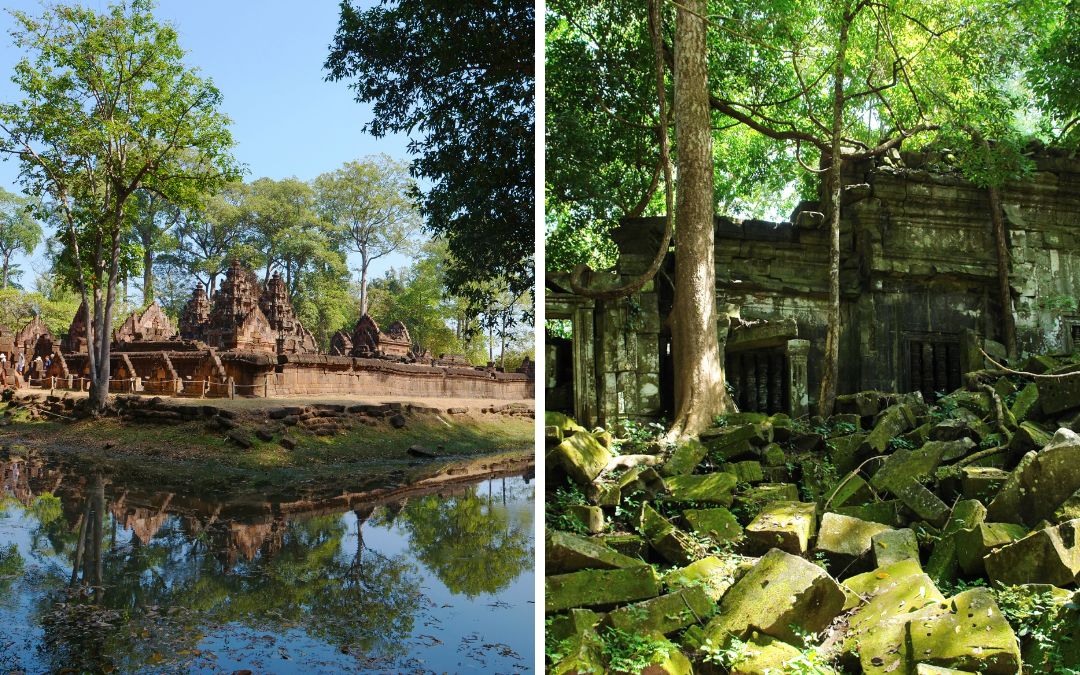
Banteay Srei and Beng Mealea attract many visitors yearly
>> See Tour: Mekong Delta to Angkor Wat
Practical Notes For Your Angkor Trip
Best Times to Explore the Angkor Complex
The Angkor Archaeological Park in Cambodia has distinct seasonal variations that greatly affect the visiting experience:
- Dry and Cooler Season (November to March)
This period offers the most pleasant weather for exploring, with average temperatures ranging between 24°C and 26°C. It’s the ideal time for comfortable exploration, but it’s also the peak tourist season. Expect larger crowds, especially at famous temples like Angkor Wat and Bayon. Early morning visits are recommended to witness the mesmerizing sunrise and to avoid the largest crowds.
- Hot Season (April and May)
Temperatures soar to an average of 35°C, occasionally reaching up to 40°C. Visiting during the early morning or late afternoon is advisable, as the midday heat can be overwhelming. This is a good time to enjoy fewer crowds but be prepared for the heat by staying hydrated and taking breaks in shaded or air-conditioned places.
- Wet Season (June to October)
The rainy season transforms the landscape into a lush, vivid tableau with fully watered moats and vibrant greenery. While rain might seem like a deterrent, the showers are usually brief and the scenery is stunning, with fewer tourists and more opportunities for unique photographs. The temples radiate a mystical atmosphere with the added bonus of quieter explorations.
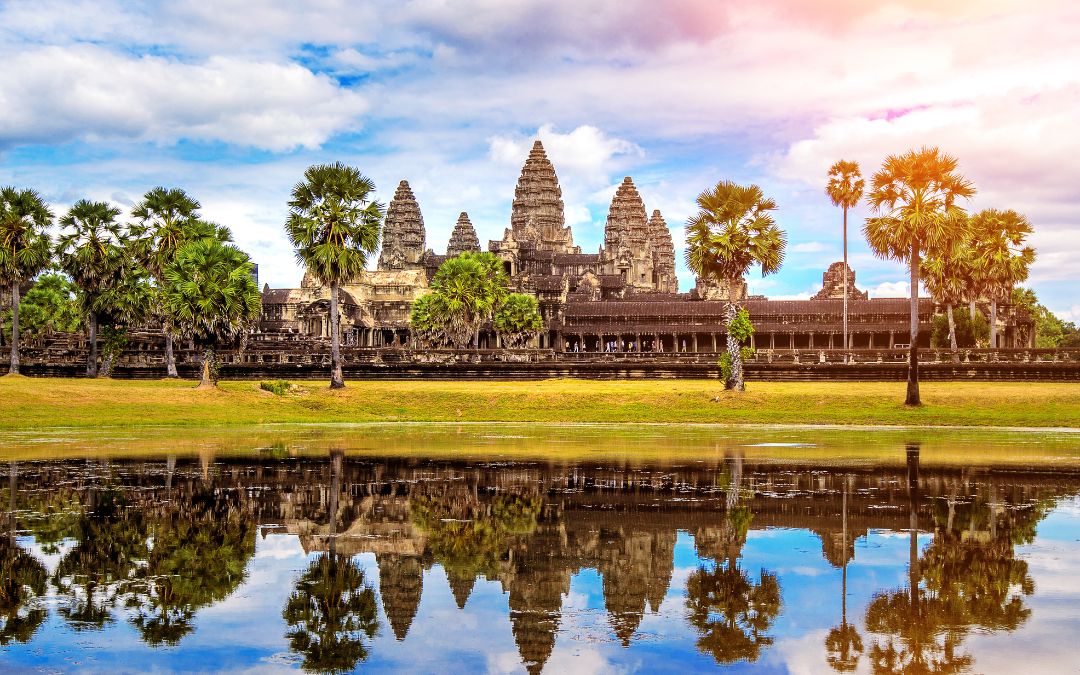
Pick the most suitable time to visit this amazing attraction
Opening Hours
- Angkor Wat Temple and Sras Srang: 5:00 to 17:30
- Phnom Bakheng and Pre Rup Temple: 5:00 to 19:00
- Other Temples: 7:30 to 17:30 PM
Ticket Information
Tickets to the Angkor Archaeological Park are essential and should be purchased from the official Angkor Ticket Centre, located at the corner of Road 60 and Apsara Road. Here are the details on ticket types and purchasing tips:
- 1-Day Pass ($37)
This pass allows multiple entries within the same day.
A helpful tip is to purchase your pass for Angkor Wat the day before your planned visit, especially after 4:45 PM. This way, you can avoid long lines during peak season and catch the sunrise at Angkor Wat the next day.
- 3-Day Pass ($62)
Valid for three entries within a 10-day period. This pass gives you the flexibility to explore at a more relaxed pace and visit more temples within the complex.
- 7-Day Pass ($72)
Valid for seven entries within a 30-day period. Ideal for those who want a comprehensive exploration of the park or wish to revisit certain sites at different times of the day or in varying light conditions.
The ticket office is open daily from 5:00 to 17:30, year-round. Ensure you buy your tickets directly from the official ticket center, as tickets purchased elsewhere are not valid. Each ticket includes a photo (for 1-day passes) or holes punched at the checkpoint (for 3-day and 7-day passes) to track entry.
Preparing For Your Trip
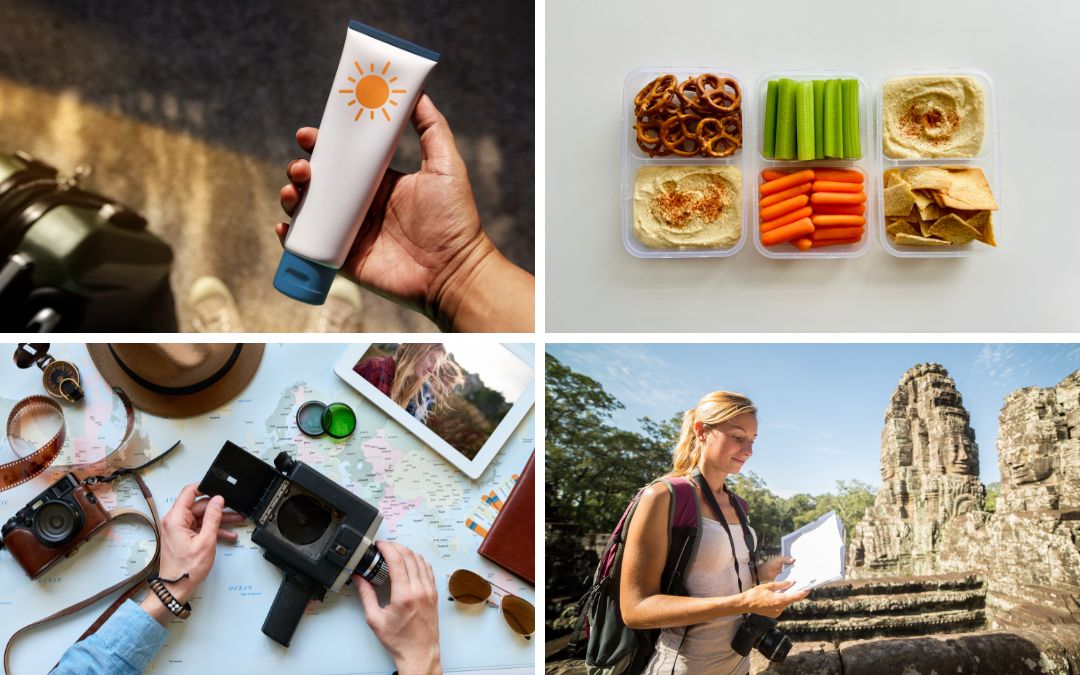
Some essential items that you should have on your Angkor trip
To make the most of your visit to the Angkor Archaeological Park, being well-prepared is key. Here are some important things to consider bringing along:
- Appropriate clothing
The weather in Cambodia can be hot and humid, especially during the dry season. Wear light, breathable clothing and comfortable walking shoes. Since you will be visiting religious sites, it’s important to dress modestly; shoulders and knees should be covered. A hat and sunglasses will help protect you from the sun.
- Sunscreen and insect repellent
Protect your skin from the sun’s strong rays with a high SPF sunscreen. Also, apply insect repellent to ward off mosquitoes, especially during the early morning and late afternoon.
- Water
Staying hydrated is crucial in the Cambodian heat. Carry a reusable water bottle that you can refill throughout the day. Many hotels and other establishments have water refill stations.
- Snacks and energy boosters
Exploring the vast Angkor Complex can be physically demanding. Bring some snacks like nuts, fruit, or energy bars to keep your energy levels up throughout the day.
- Small backpack
A comfortable, lightweight backpack is ideal for carrying your essentials like water, snacks, cameras, and personal items while keeping your hands free.
- Cash for small expenses
While the main ticket to the Angkor Complex should be purchased with a credit card or cash at the official ticket center, small expenses like local snacks, souvenirs, or donations at smaller temples are typically cash transactions. It’s good to have some Cambodian Riel or US dollars in small denominations.
- Map or Guidebook
While you can hire a guide at the park, having a map or a guidebook can help you navigate the large area and enrich your understanding of the history and significance of the different sites.
>> See Tour: The Bay to Angkor Tour
Discover the Timeless Majesty of Angkor Complex
Visiting the Angkor Archaeological Park is an enriching and unforgettable experience that offers a unique glimpse into the grandeur of ancient Khmer architecture and the cultural heritage of Cambodia. The temples, each with their own unique stories and intricate carvings, stand as a testament to the skill and artistry of the Khmer builders. Whether you’re watching the sun rise over Angkor Wat, exploring the mystical roots of Ta Prohm, or marveling at the smiling faces of Bayon, the complex captivates you with its beauty and history.
Ready to embark on an adventure of a lifetime? Craft your Cambodian holiday with Asia Pioneer Travel today and uncover the awe-inspiring sites the country offers, including the Angkor Archaeological Park and beyond.

